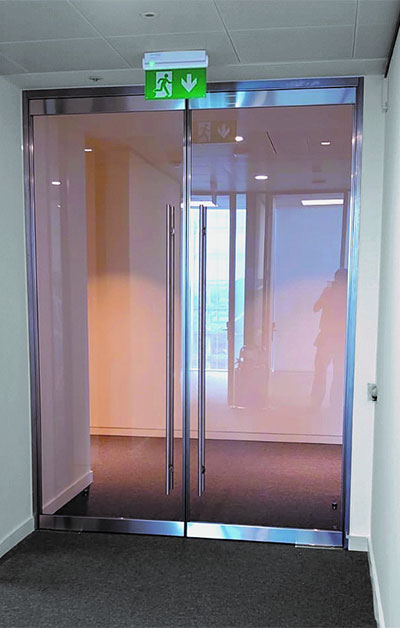A range of fire rated glass doors developed by Promat provides architects, specifiers and clients with a stylish solution that meets their passive fire protection objectives without compromising aesthetic or daylighting goals.
Three highly specialised door systems – PYROSEC® Door, PYROSEC® Slimlite and Promat E Door – have been engineered by Promat with the aim of maximising the door’s glass area and minimising the framing. They enable interior spaces to be designed in a way that facilitates high levels of natural light transmission within rooms and clear visibility between them, whilst being compliant with the fire containment and evacuation strategy.
All three systems feature high quality fire rated glass framed within horizontal and vertical frame members, stiles and rails that are manufactured in stainless steel. This combination of materials, coupled with Promat’s design expertise, has proved to be effective at resisting fire in third party testing, meaning specifiers can confidently choose glass doors with up to EI60 (integrity and insulation) protection, subject to the door’s size and design parameters.
Promat’s fire rated glass doors are designed to offer safety with style, enabling architects to meet the aesthetic and operational ambitions of clients seeking a modern design for their commercial or public buildings. They can be incorporated into fire rated glass screens, partitions and other features created using the Promat SYSTEMGLAS® fire resistant glazing system, which offers steel, timber, over-clad, paintable and concealed framing options.
 The slim framing means clean sightlines can be achieved whilst also delivering bright and airy spaces. Such environments can be important in maintaining the health and wellbeing of building users as one research study on an office building by Northwestern Medicine and the University of Illinois illustrates. Researchers found that employees exposed to natural light sleep longer and better than those who are not, and those who work near windows are exposed to 176% more natural light than those who do not.
The slim framing means clean sightlines can be achieved whilst also delivering bright and airy spaces. Such environments can be important in maintaining the health and wellbeing of building users as one research study on an office building by Northwestern Medicine and the University of Illinois illustrates. Researchers found that employees exposed to natural light sleep longer and better than those who are not, and those who work near windows are exposed to 176% more natural light than those who do not.
In addition to their physical resistance to heat and flames, fire rated glass doors play another important role in delivering safer buildings because they offer easier visibility for emergency services in the event of a fire. And Promat glass fire doors can also be specified to incorporate closer devices that are triggered in the event of a fire to offer a reactive barrier to prevent the spread of fire, heat and smoke.
Cath McLean, Sales Manager for Glass at Promat UK said, “Glass doors are often preferred to more typical fire doors, such as timber doors, because they present less of a visual barrier between individual rooms and communal spaces and allow light transmission to be higher. But the creation of more open and connected spaces has to go hand in hand with fire safety, and this is why we’ve created these three glass door options.”
The longest established of the Promat glass door systems is the PYROSEC® Door. This is a robust, stylish and dependable system available in a single or double leaf configuration, designed with slim stainless steel frame members whilst providing 30 minutes (EI30) or 60 minutes (EI60) integrity and insulation fire protection.
Where the aesthetic goal is to reduce the framing visibility to the absolute minimum whilst also achieving a fire rating of EI30 or EI60, PYROSEC® Slimlite is ideal. This provides assured fire protection despite having super-slim framing using sections just 20mm wide, making it suitable for building designs which demand the cleanest sightlines with maximum vision and light transmission.
Both of these integrity and insulation (EI) glazed fire doors can be complemented with side screens, with over panels possible also with PYROSEC® Doors, where supported by test data. They enable clear butt-joint glazing to be achieved and can be specified with a variety of optional fittings, including deadlocks, concealed electric latches, overhead fire door closers and surface mounted magnetic locks.
The third option in the range is the PROMAT® E Door, an elegant integrity-only fire rated solution which is available in a single or double leaf configuration with unlimited potential for side panels. This door features minimal stainless steel frame members in a design tested to provide 30 minutes (E30) and 60 minutes (E60) fire protection and it can feature a full height back to back handle or “through glass” pull handle.
Whichever glass door option is specified, they all come with clear traceability. They are manufactured by Promat and installed only by approved installers, and once fitted, they all benefit from compliance checking by Promat’s passive fire protection specialists. This is part of Promat UK’s 360-degree Wheel of Assurance, which provides additional peace of mind in the fire glass supply chain and supports the golden thread.
CLICK HERE to find out more about Promat UK’s stylish glass fire doors






